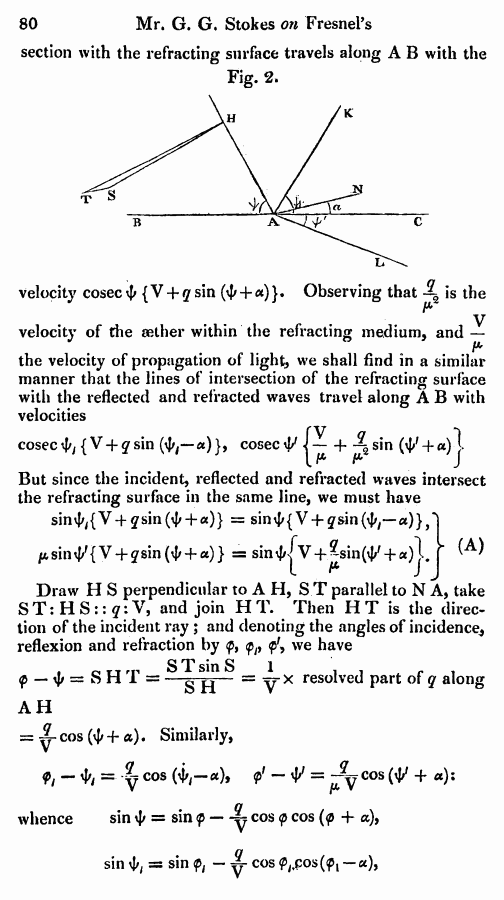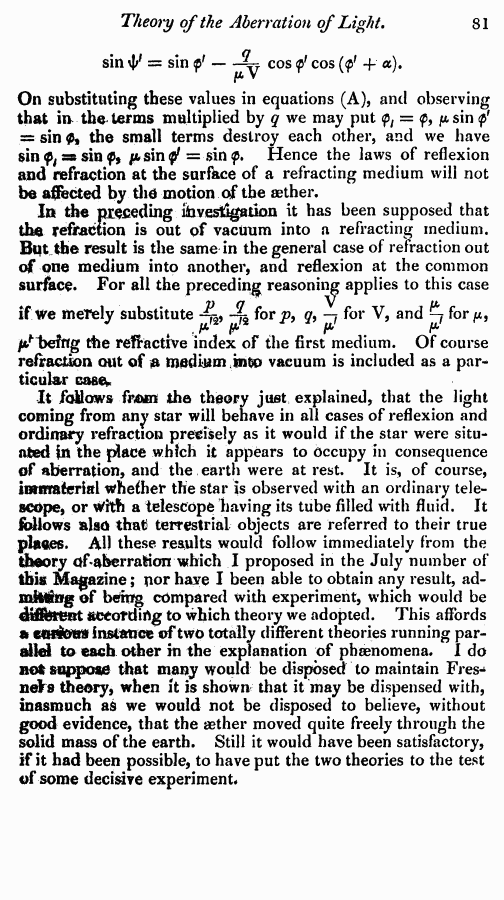

80 Mr. G. G. Stokes on FresnePs
section with the refracting surface travels along A B with the
Fig. 2.
Velocity cosec ^ {V + gsin + Observing that \ |s the
velocity of the aether within the refracting medium, and —
the velocity of propagation of light, we shall find in a similar manner that the lines of intersection of the refracting surface with the reflected and refracted waves travel along A B with velocities
cosec
4/, { V + q sin (fy— a) }, cosec V {— + \ sin (<|/ + «)").
L f* f* J
But since the incident, reflected and refracted waves intersect the refracting surface in the same line, we must have shnJ/j{V + 5,sin(4' + a)} = sintJ^V + gsinty,—«)}/
/<,sin4/{V + jsin(4' + «)} = sin\J/jv +-sin(>J/ + a)l
I ** J
(A)
Draw H S perpendicular to A H, S T parallel to N A, take S T: H S:: <7: V, and join H T. Then H T is the direction of the incident ray; and denoting the angles of incidence, reflexion and refraction by <p, <p,, <?', we have
<p — ij/ = S H T = ^ resolved part of q along
AH
= 3-. cos (4< + «)• Similarly,
ft — 'J'/ = y cos (fy—*)» <p' — ty = ^cos (i{/ + a) i whence sin \J/ = sin <p —^ cos <p cos (<p + a), sin ^ = sin <p, - y cos ^,pos(f, - a),
Theory of the Aberration of Light.
81
sin 4/ = sin $9 — cos <pf cos -f a).
On substituting these values in equations (A), and observing that in the terms multiplied by q we may put <p{ = ft sin <p* = sin0, the small terms destroy each other, and we have $in ss sin ffcsin^ = sinp. Hence the laws of reflexion and refraction at the surface of a refracting medium will not be affected by did motion of the aether.
In the preceding investigation it has been supposed that the refraction is out of vacuum into a refracting medium. But the result is the same in the general case of refraction out of one medium into another, and reflexion at the common surface* For all the preceding reasoning applies to this case
if we merely substitute for p, q9 — for V, and ^ for/x,
/^“befng the refractive index of the first medium. Of course refractson out of a medium infc> vacuum is included as a particular case*
It follows fafi»n the theory just explained, that the light coming from any star will behave in all cases of reflexion and ordinary refraction precisely as it would if the star were situated in the place which it appears to Occupy in consequence of aberration, and the earth were at rest. It is, of course, immaterial whether the star is observed with an ordinary telescope, or With a telescope having its tube filled with fluid. It follows also that terrestrial objects are referred to their true places. AD these results would follow immediately from the tfoeory 0f-aberraHon which I proposed in the July number of tbis Magazine; nor have I been able to obtain any result, ad-mkting of being compared with experiment, which would be d&Sb*e$t aeeofdirtg to which theory we adopted. This affords a emifcttB instance ©f two totally different theories running parallel to each other in the explanation of phsenomena. I do not suppose that many would be disposed to maintain Fres-^ neVs theory, when it is shown that it may be dispensed with, inasmuch as we would not be disposed to believe, without good evidence, that the aether moved quite freely through the solid mass of the earth. Still it would have been satisfactory, if it had been possible, to have put the two theories to the test of some decisive experiment*